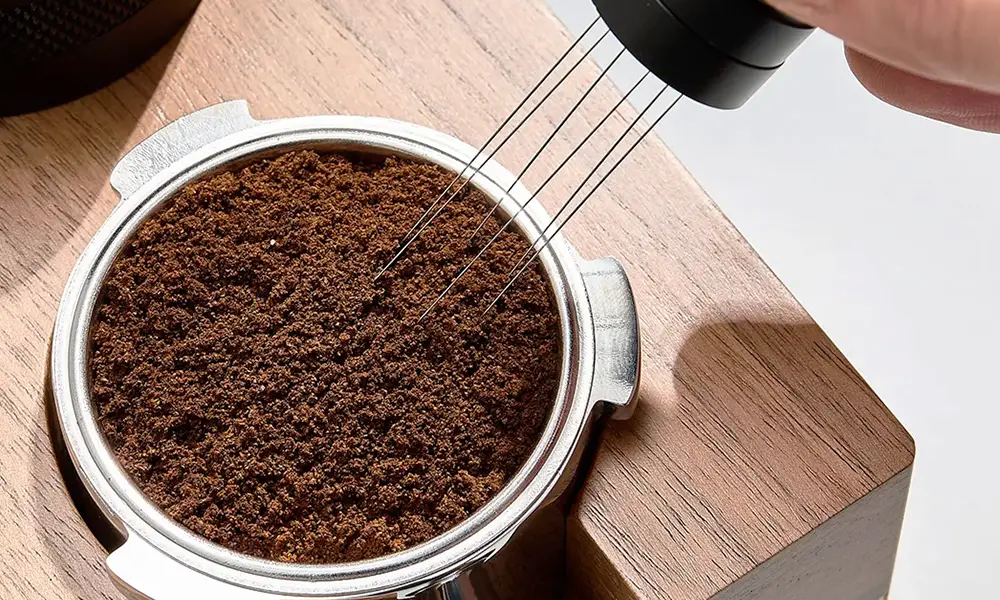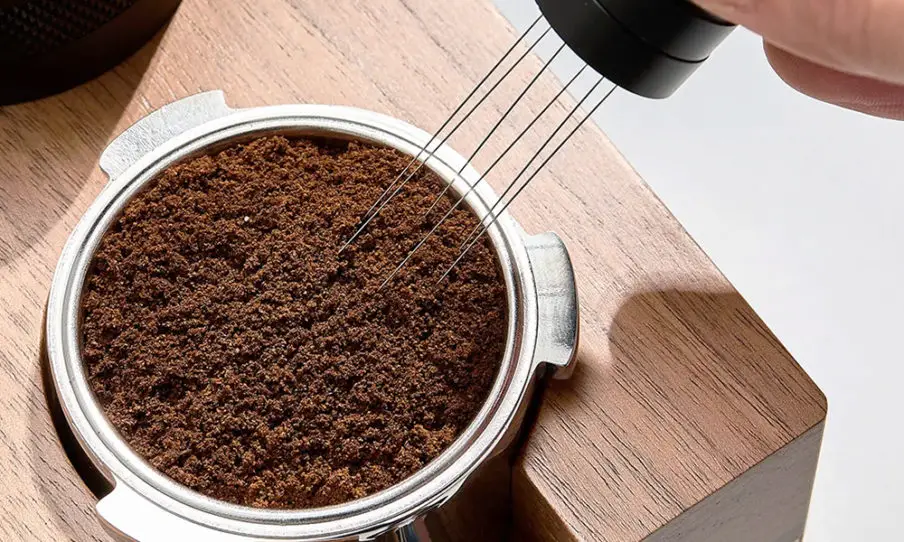
As any espresso fanatic knows (including myself), precision and consistency are everything when it comes to pulling the perfect shot. While commercial espresso machines have advanced technology to optimize pressure, temperature, and infusion, a barista’s prep work before tamping and pulling a shot also plays a crucial role.
This is where WDT tools enter the equation, offering the ultimate in advanced manual pre-tamping techniques for your home espresso routine.
In this article, I’ll explore what exactly WDT tools are, what they do, why they matter for making espresso, and how to use them for dramatically enhancing your shots. Read on to unlock the secrets to manual espresso precision with WDT.
What Is WDT?
WDT stands for “Weiss Distribution Technique,” named after Dr. Matt Perger, former World Barista Champion who developed and popularized the method. Put simply, WDT is a manual technique for evening out the coffee grounds before tamping by stirring, breaking up clumps, and evenly redistributing them in the portafilter basket.
This achieves a uniform compact density when tamping to optimize water flow and extraction when pulling the shot. The goal is to minimize channeling where water creates “channels” through lower density areas, an effect that leads to uneven extraction.
WDT takes an active, hands-on approach to pre-tamping prep rather than relying solely on the grinder, dosing tool, or passive distribution from tapping or vertical drops into the basket. For espresso obsessives, it offers the ultimate consistency and control.
Why WDT Matters
You may be wondering why such an involved pre-tamping technique is necessary. Can’t you just grind, dose, and tamp your way to a decent shot? While traditional methods make good espresso possible, the Weiss Distribution Technique (WDT) aims to make perfection more attainable by ensuring an even extraction and a more consistent flavor profile.
The art of making the perfect espresso shot is a delicate balance between various factors such as grind size, dose, and tamping pressure. Each element plays a crucial role in achieving the desired extraction and flavor. However, even with careful attention to these factors, inconsistencies can still occur, resulting in subpar shots.
That’s where the WDT comes in. This technique involves using a needle or a thin stirrer to create a uniform distribution of coffee grounds in the portafilter basket before tamping. By gently agitating the coffee grounds, it helps break up any clumps or unevenness that may have formed during the grinding process.
The goal of the WDT is to ensure that water can flow through the coffee grounds evenly, extracting the desired flavors and aromas without any areas being over or under-extracted. This technique maximizes the surface area of the coffee grounds that come into contact with water, leading to a more balanced and consistent extraction.
One of the key benefits of the WDT is its ability to minimize channeling. Channeling occurs when water finds a path of least resistance through the coffee puck, resulting in uneven extraction. By using the WDT, baristas can prevent channeling by creating a more uniform density throughout the puck, allowing for a more even flow of water.
Moreover, the WDT also helps improve the visual appearance of the coffee puck after tamping. With traditional tamping methods, it’s not uncommon to see uneven surfaces or clumps of coffee grounds. However, with the WDT, the coffee grounds are evenly distributed, resulting in a smooth and consistent surface that promotes a more even extraction.
While the traditional grind, dose, and tamp method can produce good espresso, the WDT takes it a step further by enhancing the extraction process and ensuring a more consistent and flavorful shot.
Here are some key benefits of incorporating WDT for noticeably enhancing shot quality:
- Improves consistency – Minimizes variables like clumping that change from shot to shot.
- Optimizes extraction – Evens saturation and avoids channeling for balanced flavor.
- Enhances texture – Produces thick syrupy shots with finer microfoam crema.
- Allows finer grinds – Decreases risk of channeling from ultra-fine grounds.
- Distributes density – Creates uniform compactness when tamping.
- Easy perfection – Takes precision out of the grinder’s “hands” and into yours.
It may seem like an extra step, but for those who are passionate about their espresso, the WDT is a valuable technique that can elevate the quality of their brews to new heights.
So, the next time you’re making espresso, consider giving the Weiss Distribution Technique a try. You might be surprised at the difference it can make in the taste and overall enjoyment of your favorite caffeinated beverage.
WDT Tools and Technique
Now that we know why WDT matters, let’s look at how it’s done and the tools involved. Professional-grade WDT tools allow baristas to stir, break up, and rake grounds with speed and precision. But several more affordable at-home options bring that power into your kitchen.
These generally consist of a base/handle, needles of varying thickness, and occasionally a tamper built into the base. Models like the IKAPE Spaceship Espresso WDD , Normcore V4 Coffee Distributor, and FusedLine Metal WDT Tool all offer high quality under $50.
The general WDT technique involves these steps:
- Dose grounds into portafilter basket evenly
- Use thin needles to break up clumps and loosen grounds.
- Stir grounds with thicker needles using a circular motion.
- Use angled needles to sweep grounds flat and distribute edges.
- Lightly tap to settle and do a visual inspection.
- Tamp uniformly with recommended 30 lbs pressure.
- Polish tamped puck and rinse excess grounds.
- Pull shot and enjoy your WDT enhanced espresso!
The stirring motion combines vertical downward pressure with a clockwise circular motion applying light lateral pressure on the basket walls. The goal is to spread grounds evenly without compressing too much before tamping.
It’s helpful to check your work with a visual inspection before tamping. Look for an even surface with grounds evenly distributed to the edges.
Some Final tips:
- Keep the tool as vertical as possible throughout the process.
- Work quickly to avoid grounds drying out.
- Adjust your pressure and number of stirs based on coffee varietal and age.
- Combine with other advanced techniques like nutation tamping.
- Keep your WDT tools clean to avoid oil buildup.
Consistency Is King
By adding a WDT tool and workflow to your ritual, you gain an impressive level of control over your shot outcomes. While learning the nuances of pressure and motions takes practice, it will quickly become second nature. Along with quality beans, equipment, and water, WDT lets you minimize variables for pulling your most balanced, flavorful shots every time.
For espresso geeks, no piece of equipment feels quite as good as a purpose-built stainless steel WDT tool. Beyond just results, incorporating WDT into your routine connects you to the craft’s heritage and community of innovators constantly perfecting and sharing techniques. Each precise stir of the grounds and coordinated swirl of the tool brings you one step closer to espresso nirvana.


